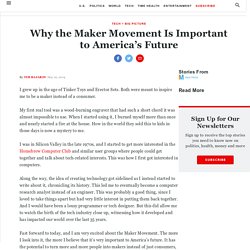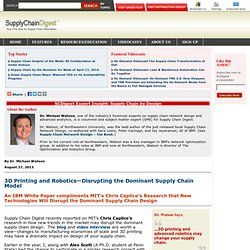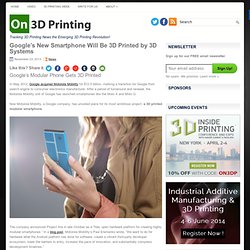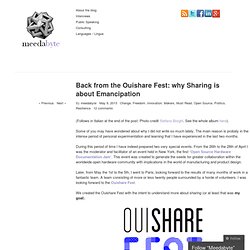

Open Source Aquaponic Greenhouse. Come costruire un FabLab in 118 slides! Why the Maker Movement Is Important to America’s Future. I grew up in the age of Tinker Toys and Erector Sets.

Both were meant to inspire me to be a maker instead of a consumer. My first real tool was a wood-burning engraver that had such a short chord it was almost impossible to use. When I started using it, I burned myself more than once and nearly started a fire at the house. How in the world they sold this to kids in those days is now a mystery to me. I was in Silicon Valley in the late 1970s, and I started to get more interested in the Homebrew Computer Club and similar user groups where people could get together and talk about tech-related interests. Along the way, the idea of creating technology got sidelined as I instead started to write about it, chronicling its history. Fast forward to today, and I am very excited about the Maker Movement.
MITCityFARM. Supply Chain By Design: 3D Printing and Robotics - Disrupting the Dominant Supply Chain Model. Supply Chain Digest recently reported on MIT’s Chris Caplice’s research in how new trends in the market may disrupt the dominant supply chain design.

The blog and video interview are worth a view—changes to manufacturing economies of scale and 3D printing may have a dramatic impact on design of your supply chain. Earlier in the year, I, along with Alex Scott (A Ph.D. student at Penn State) had the chance to participate in a similar research project with IBM. IBM was trying to understand how 3D printing, advanced robotics, and open source hardware would impact the supply chain for the electronics industry. For this study, IBM looked at the hearing aid, cell phone, LCD display, and washing machine industries. Wiki - Welcome. Open Hardware Timelines. Your Next Tomato Might Be Grown by Air. Despite the cold outside, inside MIT’s CityFarm bell peppers, eggplants, and tomatoes are ripening for an early February harvest.

Unlike conventional farming methods, many of CityFarm’s plants are being grown with air. Photo: Aleszu Bajak Founded by Caleb Harper MArch ’14, CityFarm is an MIT Media Lab initiative designed to explore the large-scale adoption of both aeroponics and hydroponics to “invent the future of agriculture,” according to their website. Unlike traditional farming, which irrigates and uses soil as structural support, an aeroponic plant’s roots are fed a mineral-enriched mist and protected in boxlike chambers. Plants are exposed to spectrally-optimized LED lights and are constantly evaluated to ensure optimum growing conditions. The results? Aeroponics uses 98 percent less water than conventional farming, and plants can grow 365 days a year inside and in much smaller areas. Such detailed tracking of energy inputs and produce outputs is new to farming. Kano: A computer anyone can make by Kano. Google's New Smartphone Will Be 3D Printed by 3D Systems.
Google’s Modular Phone Gets 3D Printed In May 2012, Google acquired Motorola Mobility for $12.5 billion, marking a transition for Google from search engine to consumer electronics manufacturer.

After a period of turnaround and renewal, the Motorola Mobility unit of Google has launched smartphones like the Moto X and Moto G. Now Motorola Mobility, a Google company, has unveiled plans for its most ambitious project: a 3D printed modular smartphone. The company announced Project Ara in late October as a “free, open hardware platform for creating highly modular smartphones.”
In a blog post, Motorola Mobility’s Paul Eremenko wrote, “We want to do for hardware what the Android platform has done for software: create a vibrant third-party developer ecosystem, lower the barriers to entry, increase the pace of innovation, and substantially compress development timelines.” And in the most recent update to Project Ara, 3D Systems has been selected as the 3D printing partner for the new phone. US federal shutdown puts key science functions on hold - science-in-society - 01 October 2013. » Fairphone ce l’ha fatta: lo smartphone “etico” ha raccolto abbastanza fondi e arriverà ad ottobre! » Smartphone. Back from the Ouishare Fest: why Sharing is about Emancipation. (Follows in Italian at the end of the post.

Photo credit Stefano Borghi. See the whole album here). Some of you may have wondered about why I did not write so much lately. The main reason is probaly in the intense period of personal experimentation and learning that I have experienced in the last two months. During this period of time I have indeed prepared two very special events. Later, from May the 1st to the 5th, I went to Paris, looking forward to the results of many months of work in a fantastic team. Fibre processing tools and machines that the whole world can use and help improve. There are a lot of different processes involved in creating a finished product, such as an article of clothing, from wool that’s still riding round on a sheep’s back.

All of these steps have been automated in various ways during the industrial revolution, and various tools and techniques have been tried. Many of them are opportunities for small scale crafters to create unique and creative products, but also, many of these steps can be drudgery if carried out in large volumes without machinery. So, lets dive into the main areas of wool processing to make fabric, and perhaps you’ll see some areas in need of open source technology. Open Source Ecology.